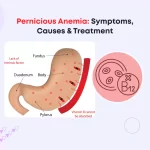
How Much CRP Level In The Blood is Considered Dangerous?
C-reactive protein (CRP) is released by the liver into the bloodstream as a response to inflammation. It serves as an early indicator of inflammatory processes in the body. Keep reading to know what CRP is, what causes its levels to rise, how to test for it, and most importantly, how to interpret CRP levels to determine if they are dangerous.
What is CRP?
CRP, short for C-reactive protein, is a protein made by the liver when the body experiences inflammation, which is how it responds to injuries, infections, or autoimmune diseases like rheumatoid arthritis. This protein acts as a defense mechanism against these health challenges. It serves as a signal for potential cardiovascular diseases and cancer.
During times of inflammation, the level of CRP in the bloodstream increases quickly. Checking CRP levels in the blood is useful—it helps identify inflammation and monitor how well treatment is working or how a condition is progressing. In simpler terms, measuring CRP is like having a health indicator alerting us to potential issues and tracking how the body responds to them.
Normal Range of CRP Level in the Blood
Typically, CRP levels are low or undetectable in healthy individuals. A normal range falls between 0 to 3 milligrams per liter (mg/L) of blood. Elevated levels may signal an underlying health concern. While there is no such thing as a “low” CRP level, the normal range is generally less than 0.9 mg/dL.
What leads to an increase in CRP levels?
CRP levels can be elevated in response to various conditions, including infections, autoimmune diseases, cancer, and cardiovascular disease. Bacterial and fungal infections can cause a rapid rise in CRP levels. Autoimmune diseases, such as rheumatoid arthritis and systemic lupus erythematosus (SLE), can cause chronic elevation of CRP levels, indicating ongoing inflammation. Additionally, CRP levels can be increased in conditions like inflammatory bowel disease, osteomyelitis, arthritis, and pelvic inflammatory disease.
Should You Be Worried About Abnormal CRP Levels?
High CRP levels do not always indicate a medical condition requiring treatment, even if the levels are slightly elevated. CRP levels can increase due to various factors, such as smoking, obesity, recent injuries, and certain medical conditions. If your CRP levels are abnormal, call us to discuss the findings and determine the underlying cause.
Medical Tests to Measure CRP Levels
CRP levels can be measured through a normal blood test. The test measures the amount of CRP in the blood, and the results are reported in milligrams per liter (mg/L).
Conclusion
In conclusion, understanding CRP levels and their significance in health is crucial for proactive healthcare. Regular monitoring with lifestyle adjustments empowers individuals to manage inflammation and reduce the risk of associated health issues. Consulting with a healthcare professional for personalized guidance ensures a comprehensive approach to maintaining optimal CRP levels and overall well-being.
Frequently Asked Questions
What happens if your CRP is high?
A high CRP level can indicate inflammation in the body, which can be caused by various conditions such as infections, autoimmune disorders, or chronic diseases. It may also be a risk factor for cardiovascular diseases.
What happens if CRP is positive?
A positive CRP test indicates the presence of inflammation in the body, which can be a sign of infection, tissue injury, or chronic diseases like rheumatoid arthritis or inflammatory bowel disease.
How to reduce CRP level by food?
Foods that can help reduce CRP levels include those rich in antioxidants and anti-inflammatory properties, such as fruits, vegetables, whole grains, nuts, seeds, fatty fish, and olive oil.
What is the treatment for high CRP?
The treatment for high CRP levels may involve addressing the underlying condition causing inflammation, such as infections, autoimmune diseases, or lifestyle changes to reduce inflammation.
What foods cause high CRP?
Foods that may contribute to higher CRP levels include processed foods, sugary beverages, refined carbohydrates, and foods high in trans fats and saturated fats.
What is a normal CRP level?
A normal CRP level is less than 10 mg/L. However, the normal range may vary slightly depending on the laboratory and the specific assay used for testing.
Why does CRP increase?
CRP increases in response to inflammation in the body, which can be caused by infections, injuries, autoimmune disorders, or chronic diseases.
How much CRP is safe?
A CRP level of less than 1 mg/L is considered low risk for cardiovascular diseases, while levels between 1-3 mg/L indicate moderate risk, and levels above 3 mg/L indicate high risk.
Which infection causes high CRP?
Various infections, including bacterial, viral, and fungal infections, can cause an increase in CRP levels as part of the body immune response to the infection.
Which doctor to consult for high CRP?
A primary care physician can initially evaluate and manage high CRP levels. Depending on
What should you not eat when CRP is high?
When CRP is high, it is advisable to avoid foods that can promote inflammation, such as processed foods, sugary snacks, refined carbohydrates, and foods high in trans fats.
How can I lower my CRP naturally?
Lifestyle changes such as maintaining a healthy weight, regular exercise, quitting smoking, and eating a diet rich in fruits, vegetables, whole grains, and healthy fats can help lower CRP levels naturally.
How can I control my CRP at home?
To help control CRP levels at home, focus on a healthy lifestyle including regular exercise, stress management, a balanced diet, and avoiding smoking and excessive alcohol consumption.
How much crp level is dangerous in a child?
In children, a C-reactive protein (CRP) level higher than 10 mg/L is considered significantly elevated and may indicate a more severe inflammatory process or infection.








